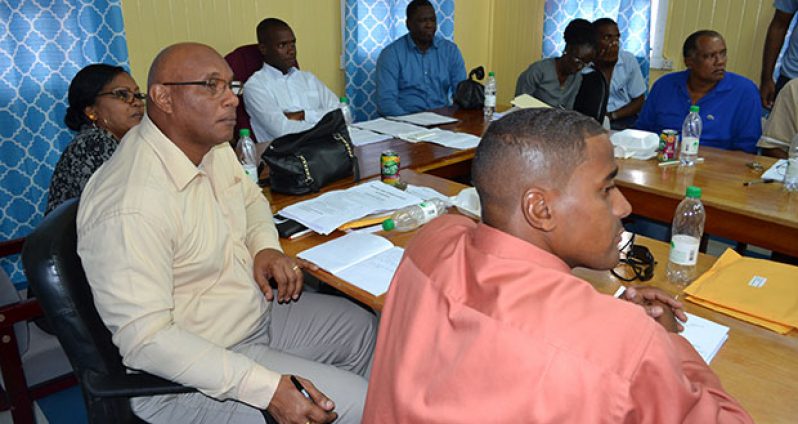GREEN jobs and income growth that promote clean energy and reduce carbon emissions and pollution are among key benefits that will be materialized when the Government rolls out the Green Bartica Development Plan -– an initiative that was unanimously endorsed by the Bartica Town Council.Crafted by the Ministries of the Presidency and Communities based on a series of consultations with stakeholders, including the Central Housing and Planning Authority (CHPA) and the Guyana Lands and Surveys Commission (GLSC), the plan has been designed to transform Bartica and all Region Seven (Cuyuni-Mazaruni) into a model green town, in keeping with President David Granger’s vision to drive Guyana’s development through sustainable initiatives.
The Town Council has adopted the plan at its statutory meeting, held last Wednesday in the boardroom of the Regional Democratic Council office.
In his address to the Town Council, and later to representatives of the business community and private sector, Presidential Advisor on the Environment, Rear Admiral (ret’d) Gary Best, explained that the plan would aid in creating policies that would lead to the sustainable development of Bartica.
“In ‘greening’, what we expect the Government will do is use both private and public investment to…drive green jobs and income growth, which promote clean energy and reduce carbon emissions and pollution to [prevent] the loss of biodiversity and eco-system services,” Advisor Best explained.
Government would also be keen to mainstream adaptation and mitigation into development; meet international standards and indicators; select and utilise alternative energy sources (solar, hydro-power and biomass) that are most economically feasible; and manage and value natural capital and land use planning, among other actions.
Adapting to a green pathway also entails sustainable harvesting of natural capital, environmental security, economic prosperity, and social cohesion and other measures.
“Sustainable means that you harvest your natural capital so that generations in the future can benefit from the same natural capital,” Advisor Best said. He also noted several benefits — principally social, economic and environmental — that would accrue and make Guyana an upper-middle income country by 2025.
Meanwhile, Agricultural Engineer Charles Griffith, in his presentation on the industrialisation and modernisation of Bartica, said his group considers the proposed Land Use Plan to be one of the most important components of the overall Green Bartica plan. The group has created an inventory of all the resources, analysed that data, then developed a strategy and a strategy proposal to provide an overall concept of the plan that covers Bartica’s extended demarcations, which measure about 68 square miles, a figure that is subject to verification by the GLSC.
“You need to have a vision of what you want this place to look like 20 years, 15 years, 5 years down the road…there are matrices that you can develop to assist you to put together a master plan of where you want to go in terms of improving your standard of living, the municipality being able to sustain itself…being able to take care of its debt…being able to provide benefits for both industries and the people of Bartica; that is the overall objective — improved standard of living, but it must be sustained,” Griffith explained.
The plan proposes to diversify the Bartica economy so that the main source of income would not be primarily from the mining sector.
“Bartica is very fortunate… it has water, it has forest products, it has minerals, it has quarrying; and with the combination of productive land and water, there come agricultural enterprises. In that context, those are the major resources,” he said.
With regard to the modernisation component, it proposes a restructuring of the drainage and sanitation system; development of recreation, tourist, light commercial, business and other areas; and expanding transportation corridors with a view to facilitating trade and connectivity to other communities, including at Goshen — to link Bartica to the Coast and to Linden, Upper Demerara/Upper Berbice.
It also proposes alternative energy options and smart metering; the agricultural cultivation of about 10,000 acres of land in the eastern section of the community; expanding and diversifying the quarrying sector in the mineral belt on the western side; and building factories.
The plan proposes several financing options, such as diaspora investment; public/private partnerships; seed capital; loans; equities and others.
The GLSC has already indicated an interest in starting to zone the industrial and new residential areas. According to the plan, zoning will be done on 70/30 agriculture to nature ratio and 50/50 development to nature ratio. Lands for pasturing have also been identified, and a recommendation has been made for some State lands to be vested into the township to attract revenue.
Bartica Mayor Gifford Marshall has expressed great optimism, positing that “the plan would bring major transformation to Bartica.”
“The plan…is timely. We know that it will give some amount of direction going forward,” Marshall noted.
However, he made it clear that the Government and the Council cannot do it alone, as he underscored the importance of having the private sector buy into the initiative.
Businesswoman Elizabeth Moonsammy expressed similar sentiments: “I am very happy with the proposed land development plan… Some of what you have presented here reflect some of the vision our foreparents had for Bartica many, many years ago… This … gives businesses here something to really think outside the…box,” she said.
Devon Schroeder of Dino Investments was also enthusiastic about the plan. “Bartica is going places!” he said.



.jpg)









